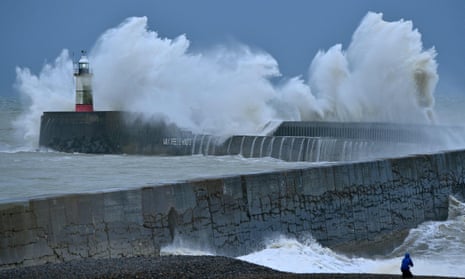More than half of Great Britain’s daily electricity came from wind turbines for the first time on Boxing Day, as the country headed for its “greenest year on record”, due in part to the coronavirus.
As Storm Bella arrived, bringing gusts of up to 100mph, wind provided 50.7% of Great Britain’s electricity according to data charting the power generation mix.
While wind briefly hit 60% in August, it had not previously sustained such levels for 24 hours.
“Britain has experienced a renewables revolution over the last decade with the growth of biomass, wind and solar power,” said Drax Electric Insights, part of coal and biomass power company Drax, which tracks the data.
The milestone follows a string of new low-carbon records set in 2020, as Covid-19 restrictions depressed power demand, helping wind and solar to claim a larger share of the mix. Fossil fuels have increasingly been edged out as a result, helping Great Britain enjoy its longest coal-free period since the Industrial Revolution.
Gas and coal power plants made up 36% of the electricity generated in England, Scotland and Wales in the year up to 21 December 2020, according to data from National Grid’s electricity system operator (NGESO), down from 46% in 2019.
Wind and solar farms delivered 29% of the electricity mix, rising from 23% of electricity generated in Great Britain last year, according to the early data report.
🌬 For the first time ever yesterday, amid #StormBella, more than half of Great Britain’s #electricity was generated by the #wind
— Drax (@DraxGroup) December 27, 2020
☔️ 5️⃣0️⃣.6️⃣7️⃣% of power was produced by wind turbines
⚡️ Previous record of 50% set on 21 August
👉🏾 https://t.co/otBFE9zO46 (👀 by @I__like__eggs) pic.twitter.com/yEU4mdRf50
While Boxing Day set a record for the highest share of power generated by windfarms, it was not a record for the most power they have ever supplied. That was set earlier this month, when windfarms delivered 17.3 gigawatts. Because overall demand was higher at the time, their percentage share of total power generation was lower than it was on Boxing Day, at 40%.
The larger role for renewables has caused the “carbon intensity” of Great Britain’s electricity to fall to its lowest level on record of 181g of carbon dioxide per kilowatt-hour of electricity, compared with an average of 215g last year and 248g in 2018.
Rob Rome, NGESO’s head of national control, said: “2020 has been a record-breaking year for Great Britain’s electricity system. The grid continues to transform at an astonishing rate as we harness the growth of renewable power sources.
“We saw the highest ever level of solar generation in April, the longest period of coal-free operation between April and June, and the greenest ever month in May,” and the wind record set earlier this month illustrated the “changing nature of electricity in Britain”.
There was a blip during August and September, when the electricity system bucked the trend of declining carbon intensity as emissions rose despite lower demand for electricity, suggesting a higher use of fossil fuels.
Tom Edwards, an analyst at the energy consulting group Cornwall Insight, said the electricity system operator increased its reliance on gas-fired power plants by 20% in September compared with the year before, amid a slump in renewable energy generation.
“To compensate for the lower wind speeds and dunkelflautes – dark, still periods – we turned to gas and coal,” he said. “It’s part and parcel of relying more on weather driven capacity and interconnector exports, which makes us more reliant on the vagaries of the wind and sun.”
Steve Jennings, a partner at the consulting firm PwC, said the “key challenge on our pathway to net zero” is what the electricity system does “when the wind doesn’t blow or the sun doesn’t shine”.
The falling cost of energy storage – such as batteries – is expected to play a major role in Great Britain’s ability to use more renewable energy, and less fossil fuel power, alongside a more flexible approach to when major energy users consume electricity.
But Jennings said nuclear power and gas-fired power plants fitted with carbon capture technology would still be required if Great Britain hopes to avoid unabated fossil-fuel generation.
“Everyone is very positive about the UK’s green energy records but I think the microscope will begin to turn to what is happening on a daily basis rather than simply a cumulative basis,” he said.
The coronavirus pandemic reduced electricity usage overall in 2020 compared with a normal year, as large swathes of the economy have been forced to shut their doors for extended periods. Average power demand across the course of the year has dropped from 32.58GW in 2019 to 30.6GW so far in 2020.
